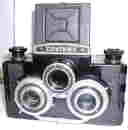
GOMZ Komsomolets
A good rip-off. The USSR took much German technology in 1945 as reparation; the Voigtlander Brillant (q.v.) was one such. The Komsomolets (c1946) is derived directly from the later (1938) bakelite Brillant body and focus only on the taking lens as for basic Brillants. Production only reached 25,000 before the Lubitel replaced it in 1949-50.
Taking lens is T-22 75mm f6.3
Shutter unnamed 1/25 to 1/100
|

GOMZ/Leningrad Lubitel
The Lubitel succeeded the Komsomolets in 1948, and is a copy of the later geared-lens Voigtlander Brillant. It was a significant improvement, although still pretty basic. It was turned out in huge quantities - over a million units in total to 1956 - and was copied by the Chinese as the rare "Changle" from 1961.
Taking lens is T-22 75mm f4.5.
Shutter ZT-5 1/10 to 1/200
|

GOMZ/Leningrad Lubitel 2
The Lubitel 2 came out in 1955 and was current until 1980, over two million being produced up to 1980. I have one still sealed in its original delivery box and never opened! The shutter is now synchronised, but otherwise only the nameplate gives it away as different from the Lubitel.
Taking lenses are T-22 75mm f4.5
Shutter ZT-5 1/15 to 1/125
|

Lomo Lubitel 166B
The factory changed its name again to Lomo by the time the 166 arrived in 1976. Bakelite went in favour of thermoplastic in very seventies style. Otherwise it's just a restyled 2. This is a 1980 166B with self-timer - the largest production variant (900,000). The basic 166 sold only 70,000 units and there's also a 166U with 6x4.5 ability (400,000 produced).
Taking lenses are T-22 75mm f4.5
Shutters unnamed 1/15 to 1/125
|

GOMZ Global 676
This item is a rebadged Lubitel-2, probably made for a distributor, although there is no mention of it in any of the reference works - including Princelle - and only a couple on the web. I must assume that very few were produced - this one is serial no. 513, and one other identified on the web is no. 281. There is a Kalimar-badged version which is more common, although I have yet to obtain one.
Taking lenses are (T-22?) 75mm f4.5
Shutter ZT-8 1/15 to 1/250
|

GOMZ/Leningrad Sputnik
This (c1955) turned the bakelite TLR into a cheap stereo camera using mostly Lubitel 2 bits. Crude but effective, using 120 film for six twinned shots - the lenses and shutters are linked by simple rod/lever arrangements. TLR can also mean "THREE-lens reflex" if you want...
Taking lenses are T-22 75mm f4.5
Shutters unnamed 1/15 to 1/125
|
